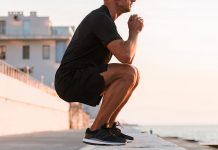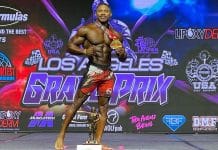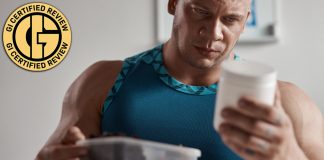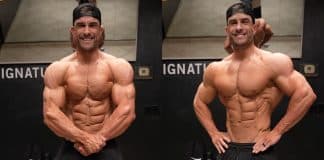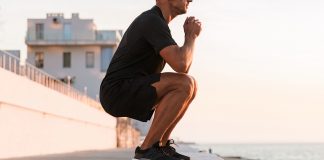
A great bodyweight exercise that requires strength, balance, focus, and endurance.
Some of us look forward to leg day, while others of us could not care less. But however you feel about it, you need it because no one will respect those chicken legs no matter how big your upper body looks. The benefits of having, big, strong legs goes far beyond a simple tree-trunk aesthetic.
It means you are more grounded, balanced, and stable for any big lift. Of course, when it comes to sport specific movements it can provide a level of power and explosivity that you need, but all in all having strong legs works more to your benefit than you know. Skater squats are a great unilateral exercise to challenge yourself and give your legs a good burn.
Unilateral training is something that should absolutely not be overlooked, for the benefit towards bodybuilding specifically is that it will work to target both sides of your body equally to eliminate any muscle imbalances that may arise. By not overtraining the dominant side and isolating certain muscles, you focus on recovery and rehab to prevent injuries and keep you in the gym.
With unilateral training, the side not being used is also stimulated so some work is done, but you get a slight reprieve as only one side is seriously targeted. Not only will this keep you grinding in the gym, but it will also lead to a healthier lifestyle overall.
Let’s take a look at skater squats and see what this exercise can do for your leg gains. From what it is, to muscles worked, and the many benefits associated with this great unilateral exercise, skater squats can certainly beef up your workout to fire up those leg muscles so those thunder thighs really start to show.
What Are Skater Squats?
Skater squats are a unilateral exercise that will challenge your balance and focus, while also enhancing strength when it comes to your lower body. While this exercise provides a good leg warm-up, it will greatly enhance your entire body and can really elevate the explosivity of each leg to generate more power from each leg respectively.
This is a common variation of the pistol squat exercise because skater squats tend to be easier on the knees and for those with physical knee pain, skater squats work to get a great workout without totally blowing them out. This is because the movement of this squat exercise requires more movement out of the hip as opposed to the knee, taking that strain off.
Muscle Worked During Skater Squats
When it comes to this exercise, what you’ll find is your lower body will be absolutely fired up, but also your core. Your main abdominal muscles along with your obliques will feel a serious burn and will work to provide great balance and stability for any big lift that may come your way. For your lower body, this exercise will target your quads, hamstrings, glutes, and calves to make for a really great lower body burn.
Benefits Of Skater Squats
Strengthen Your Glutes & Hamstrings
While this exercise has the ability to provide for a host of benefits, what you’ll find is your glute and hamstring strength will be seriously enhanced. As two of the biggest muscles in your lower body, and ones that should never be overlooked, your quads and hamstrings provide for movement, stability, and strength when it comes to lifting big and sport specific movements for virtually every sport. Neglecting to strengthen these two muscle groups would be a mistake, but thankfully, skater squats work both at the same time (1).
Develop Single Leg Strength & Power
While single leg strength and power may seem unnecessary, any movement including a pivot or sudden turn will be greatly enhanced. For bodybuilders, while this may seem like a useless movement, it will allow you to better diversify your workouts to see great growth when it comes to other aspects of your training you wish to enhance. The explosivity that will come from a single leg movement is nothing to be overlooked.
Enhance Stability & Balance
While this may go without saying, it is a great benefit that needs to be mentioned. By promoting stability and balance, you are able to ground yourself and have more confidence when it comes to those big lifts, especially the big three in the deadlift, bench press, and squat. As skater squats work your core, you will feel a great sense of stability coming from you abdominals being worked as that six-pack starts to poke through (2).
Great Alternative To Other Squat Exercises
Skater squats serve as a great alternative to other exercises like the pistol squat, which can be tough on your knee. What a good alternative exercise can do is alleviate any unwanted pain and strain that can come from your knees or low back. The pistol squat, for example, uses your knees as the main point of movement, so for those with sensitive knees, it won’t be a great exercise to do. The skater squat works as a great alternative because it uses your hips as the main point of movement.
How To Perform Skater Squats
Pick one side of your body to focus on first. Once in a stable position, engage your core and make sure your glutes are ready to go. Take one leg and kick your heel backwards, bending at your hips with your front leg bent at your knee. It will look like a lunge, but more of a gliding motion. As you come back to the starting position, work to stay balanced using your arms for support in front of you. Repeat for your desired number of reps.
Wrap Up
Skater squats are a great way to target your lower body while also providing great support for balance and coordination. Lower body strength can work wonders for power and explosivity, while also giving you great gains when it comes to overall lower body strength. Easier on your knee and more focused on a hip movement, this can take pain and strain away and provides for a great alternative squat exercise. Give skater squats a try and really work to promote that lower body growth for great gains to your fitness and physique.
Let us know what you think in the comments below. Also, be sure to follow Generation Iron on Facebook, Twitter, and Instagram.
References
- McAllister, Matt J.; Hammond, Kelley G.; Schilling, Brian K.; Ferreria, Lucas C.; et al. (2014). “Muscle Activation During Various Hamstring Exercises”. (source)
- Akuthota, Venu; Ferreiro, Andrea; Moore, Tamara; Fredericson, Michael (2008). “Core Stability Exercise Principles”. (source)
*Images courtesy of Envato







